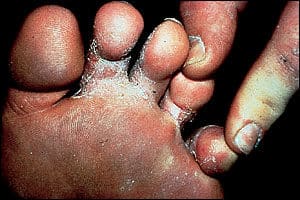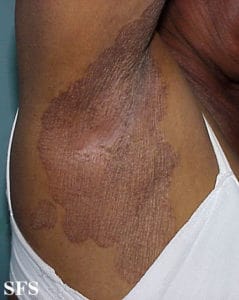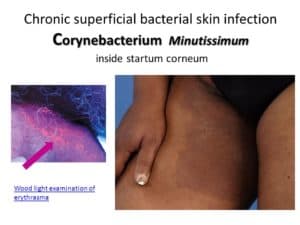It is an infection of the skin caused by Corynebacterium minutissimum. Risk factors for developing erythrasma include: obesity, diabetes, warm climate, delicate cutaneous barrier (in case of bleaching), excessive sweating, and poor hygiene.
It commonly affects the toe-clefts, armpit, areas where the thighs are in close contact with the scrotum, areas below the breast.
Erythrasma is classified into 3 types according to location.

Toes affected by Erythrasma
- Interdigital erythrasma: between 3rd, 4th and 5th toe web spaces

Armpit affected by erythrasma
2. Intertriginous erythrasma: in armpits, groin, under the breasts and umbilicus
3. Generalised/disciform erythrasma: on the trunk
INVESTIGATIONS
The disease must be differentiated from ring worm. Examination under Wood’s light often shows a characteristics orange-red fluorescence.

Wood light examination of erythrasma.
TREATMENT
A two-week course of erythromycin or tetracycline is curative. Though, recurrence may occur.
Use of antibacterial soap may also be helpful and topical erythromycin preparations may also be used.
The use of Miconazole is also recommended.
FURTHER READING
- A compendium of clinical Medicine by A.O. Falase and O.O. Akinkugbe.
- DermnetNZ
- Medscape
IMAGE CREDIT: Google image

Dr. Adeyemo Olusola is a medical graduate of Olabisi Onabanjo University, Ogun State, Nigeria along with certificate in advanced diploma in Principles of Nutrition, Management and Leadership, Dublin and Certificate in Global Health from London School of Hygiene and Tropical Medicine. In addition to his numerous certifications, he is a certified Telemedicine Physician from Harvard Medical School, USA. He is an avid reader of books from different oases of life, expert in data analysis. “So many a time, I have seen people die avoidable death because of lack of knowledge or information, falling victim of fate. There is then a necessity laid on us to help arm our society to the teeth, as a healthy society cannot be detached from an informed one. Hence, there is need for healthgist.net. We hope you will have a wonderful stay on our website.”

